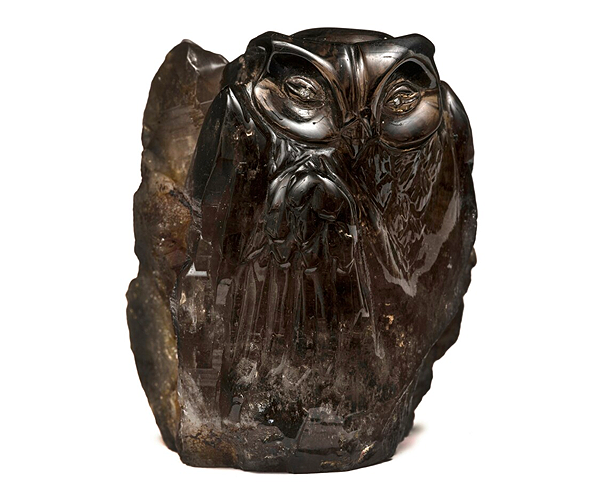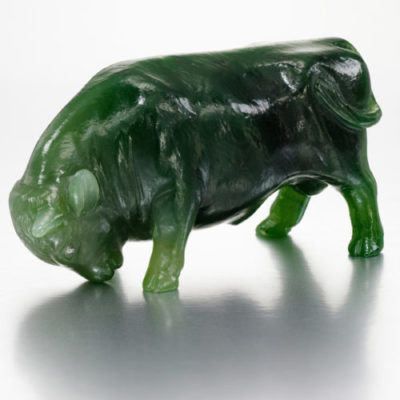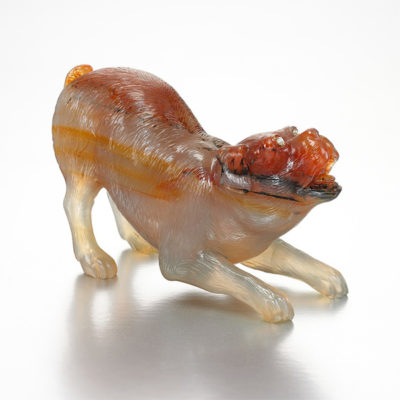
Сhristie’s Paris, 20 November 2024, Lot 24, Fabergé Kiwi, Estimate 70,000 – 90,000 EUR, Lot sold: 378,000 EUR
A Fabergé Kiwi in grey agate (c.1910), 7cm tall, fetched a colossal €378,000 at Christie’s Paris on 20 November 2024. That price (equivalent to $398,000, £315,000, or a mind-numbing 675,000 New Zealand Dollars) includes an eye-watering 26% buyer’s premium: the hammer came down at €300,000 against what I thought was a substantial, if not unreasonable, estimate of… €70,000-90,000.
I reckon I either know personally, or have heard of, most of the world’s big Fabergé collectors, but maybe they’ve been joined by a couple of very rich and patriotic New Zealanders. Apart from being the mascot of the ‘Land of the Long White Cloud,’ the Kiwi – a distant cousin of the emu – is renowned for its inability to fly. That didn’t stop this one soaring through the clouds into the stratosphere – reflecting the current sky-high demand for Fabergé hardstone creatures.
The bird was made by workmaster Henrik Wigström. It looks a beauty (I have not seen it in person), with rose-cut diamond eyes, a long gold beak, two gold legs and goldsmith’s marks under its clawed feet – including a mark which, says Wartski’s Kieran McCarthy, was used only from late 1910 until 7 March 1911, exclusively for Fabergé items made in Russia for sale in London. The Kiwi resurfaced at Bernhard Magaliff Antikviteter in Stockholm in 1970, when it was purchased by a Swedish diplomat; it was offered at Christie’s by one of his descendants, arousing fierce competition from five bidders, both old and new.
Christie’s assert that over 200 hardstone creatures were sold in Fabergé’s London store in the decade from 1906 to 1916, with over one-third of them birds – including a slightly smaller Kiwi in brown agate, also by Wigström but just 5.5cm tall, bought by Neil Primrose (son of former Prime Minister Lord Rosebery) for £26 5s in 1908. In 1953 this entered the British Royal Collection – one of the largest collection of Fabergé hardstone creatures in the world… most of them doubtless purchased from the firm’s London outlet.
Alexander Ivanov claims that his ‘Fabergé Museum’ in Baden-Baden boasts the largest collection of hardstone animals on earth, which may well be true – but most of them date from the 21st century, over one hundred years after Fabergé’s passing. Some say they’re all tawdry fakes. How can that be? Ivanov is a learned authority – a ‘Professor,’ no less! Such an academic title carries weight and prestige in modern-day Russia. Between 2004 and 2014, in Moscow, I was offered a doctorate several times, for about $10,000. I dare say Ivanov (who has friends in high places) must have got his for a knock-down price.
A further two Fabergé Kiwis are known: a third by Wigström, in brown agate, sold at Christie’s Geneva on 18 November 1980; and a second grey Kiwi, this time by Perkhin, sold at Christie’s Geneva (from the Collection of the late Sir Charles Clore) on 13 November 1985.
*
- Sotheby’s London, 2 December 2020, Fabergé Cat, Estimate 45,000 – 65,000 GBP, Lot sold 151,200 GBP
- Sotheby’s London, 2 December 2020, Fabergé Billy Goat, Estimate 50,000 – 70,000 GBP, Lot sold 138,600 GBP
- Sotheby’s London, 2 December 2020, Fabergé Bull, Estimate 50,000 – 70,000 GBP, Lot sold 176,400 GBP
- Sotheby’s London, 2 December 2020, Fabergé Rabbit, Estimate 45,000 – 65,000 GBP, Lot sold 100,800 GBP
- Sotheby’s London, 2 December 2020, Fabergé Dog, Estimate 45,000 – 65,000 GBP, Lot sold 138,600 GBP
- Sotheby’s London, 2 December 2020, Fabergé Bear, Estimate 40,000 – 60,000 GBP, Lot sold 107,100 GBP
- Sotheby’s London, 2 December 2020, Fabergé Bear Cub, Estimate 40,000 – 60,000 GBP, Lot sold 94,500 GBP
- Sotheby’s London, 2 December 2020, Fabergé Mouse, Estimate 40,000 – 60,000 GBP, Lot sold 119,700 GBP
Three recent London sales of important Fabergé collections give us an idea of the current market for Fabergé hardstone creatures. On 2 December 2020, at Sotheby’s, eight items from the Brooklyn Museum sold for a total of just over £1m, led by a nephrite Bull at £176,400. On 29 November 2021, at Christie’s, 22 hardstone creatures from the Wolf Collection totalled £1.64m, with a top price of £150,000 for both a composite hardstone Blue Tit and an agate Capercailzie. Then on 30 May 2024, at Elmwood’s, 20 hardstone creatures from an anonymous collection fetched a combined £2 million – with an obsidian model of a Dust-Bathing Sparrow, modelled on a netsuke, selling to Japan for a whopping £525,000 (against an estimate of £40,000-60,000).
- Christie’s London, 29 November 2021, Lot 17, Fabergé Capercailzie, Estimate 50,000 – 70,000 GBP, Lot sold 150,000 GBP
- Christie’s London, 29 November 2021, Lot 1, Fabergé Cat, Estimate 15,000 – 25,000 GBP, Lot sold 137,500 GBP
- Christie’s London, 29 November 2021, Lot 5, Fabergé Blue Tit, Estimate 50,000 – 70,000 GBP, Lot sold 150,000 GBP
- Christie’s London, 29 November 2021, Lot 5, Fabergé Duckling, Estimate 20,000 – 30,000 GBP, Lot sold 75,000 GBP
- Elmwood’s London, 30 May 2024, Fabergé Sparrow, Estimate 40,000 – 60,000 GBP, Lot sold 525,000 GBP
Meanwhile, in Dallas on 17 May 2024, Heritage sold a purpurin Elephant (topped by an enamel turret) for $312,500 and a Cockerel (with its original fitted case) for $300,000. Bizarrely, both Elephant and Cockerel were among numerous items from the sale available afterwards for RE-sale on the Heritage website with a 25% mark-up. This meant the Elephant was available for $390,625 – a sum, according to the website, that ‘was not set by the owner and does not indicate that they will accept the offer. The minimum offer amount, unless overridden by the owner, is set to the purchase price plus 25%, increasing to 50% after 7 days.’ … In other words, if you fancy a purpurin elephant, you can now make an offer of $468,750 that the owner (who paid $312,500 for it six months ago) may or may not accept.
- Heritage Action, 17 May 2024,Lot 82006, Fabergé Cockerel, Lot sold 300,000 USD
- Heritage Action, 17 May 2024, Lot 82030, Fabergé Elephant & Castle, Lot sold 312,500 USD
Who buys something from an auctioneer with the intention of selling it through the same auctioneer straight afterwards? A collector afflicted by ‘buyer’s remorse’? Having spent his or her last penny, and desperate to recoup their investment immediately? I guess that can happen every now and again – but hardly often enough for an auction firm to make it company policy! Who’s going to buy an item for 50% more than it cost a week ago? What’s the mark-up after no one’s wanted the thing for a couple of months?? 1000% ???
*

Sotheby’s Geneva, Lot 1291, Fabergé (?) Owl, Estimate 8,000 – 12,000 CHF, Lot sold 52,920 CHF
Any successful market attracts forgers. Fabergé hardstones are no exception. One singular item caused a stir at Sotheby’s Geneva on 15 November 2022: a smoky quartz Owl that flew to a quadruple-estimate CHF52,920 (£47,250). Its ‘reverse side’ was described as ‘left in its natural, rough state.’ A remarkable state of affairs. I’ve never seen a Fabergé creature left partly in a ‘natural, rough state’ – i.e. unfinished. I’ve never seen a bona fide Fabergé hardstone figure that wasn’t fully carved, and I bet no one else (including the personnel of Sotheby’s Russian Department) has either. There was no way I – or any of the Fabergé scholars and respected dealers I spoke to – could endorse the authenticity of this half-finished Owl. Sotheby’s didn’t help their case with a ludicrous claim that the quartz was quarried in the Cairngorm mountains near Queen Victoria’s home at Balmoral; or, when insisting on the item’s imperial provenance, by confusing Empress Alexandra (wife of Tsar Nikolai II) with Queen Alexandra (wife of King Edward VII). The Owl has never been exhibited, and surely never will be: no serious Fabergé exhibition organizer would touch it with a barge-pole.
To be indubitably authentic, a Fabergé hardstone bird or animal needs to have documented provenance, exhibition history and the green light from a respected expert (not Alexander Ivanov (read more)). It helps if the piece has been illustrated in a respected publication (not in a book by people with no business to write about Fabergé) and retains its original fitted case. Careful, though: there are lots of Fabergé cases knocking around. Auctioneers sell original, empty cases that smart asses rearrange for their criminal needs, i.e. to stick forgeries in.
Talking of Fabergé forgeries, I was contacted some years ago by Evgeny Belousov, who used to work for the stonecutting workshop opened by Alexander Leventhal (read more) in St Petersburg in 2002. The workshop’s leading client, recalls Belousov, was Alexander Ivanov – owner of the so-called ‘Fabergé Museum’ in Baden-Baden, where forgeries are two-a-pfennig.
Ivanov, asserts Belousov, ‘basically kept the workshop going. What struck me was how all his orders were based on Fabergé. Sometimes I had to copy works straight from museum catalogues. There were also customized sculptures. I saw items we had supplied to Ivanov appearing in books, having somehow become antiques. Elephants were made in huge quantities, of different sizes and from different stones. One day Ivanov placed an order for over 100 elephants! We couldn’t handle the entire order ourselves so we had to use other stone-cutters as well. Every month these elephants were taken to Moscow in buckets; there wasn’t even time to pack them. I can’t give the exact number of items handled by Leventhal’s workshop, but I reckon there were at least 200.’
Ivanov did not seem to be putting these works up for sale, thought Belousov – ‘at least not publicly… all the items quietly found their way into his private museum.’
- Lot 213
‘Fabergé’ Kiwis shown by ‘Professor Ivanov’ at his laughable Kostroma Exhibitions in 2010 & 2011 – in Bowenite (left) and Rhodonite (right)
In 2012 Ivanov published a hardback catalogue to what he calls his museum’s Fabergé Zoo, featuring 112 hardstone figures – over one-fifth of them (23) elephants. Over two dozen of these hardstone critters had been let out of their cages (or rather, cheap glass showcases) in 2010 and 2011 to grace two exhibitions Ivanov staged in the modest Russian provincial town of Kostroma. In 2010 their number included an agate Kiwi, 9cm tall, dated 1899-1903 and assigned to Mikhail Perkhin; then, in 2011, a Kiwi of the same height, made from rhodonite by an unspecified workmaster (although purportedly with its original box). I’d like to think the dodgy-looking pair have since fluttered into a long, white, impenetrable cloud.
‘Fabergé’ Hardstone Figures from the catalogue of the scandal-plagued 2020/21 Hermitage Exhibition
The ‘Fabergé’ show staged in the Hermitage by Mikhail Piotrovsky in 2020/21 was replete with Ivanov’s nefarious merchandise, included nine hardstone animals – seven of them from Baden-Baden: an agate Mouse, a bowenite Chameleon, a chalcedony Kangaroo, a jasper Lion, an agate and heliotrope Snail, an opal/moonstone Elephant (bearing a nephrite clock), and a sandstone match-holder in the shape of a Bird. All were shown in the Fabergé Style exhibition held at the New Jerusalem History & Art Museum in Istra, west of Moscow, in 2018/19; so was an obsidian Seal owned by Ivanov’s nefarious ‘Russian National Museum’ in Moscow.
According to the blurb about the exhibition on the Hermitage website, Piotrovsky hopped into bed with Professor Ivanov because he was an ‘Expert’ approved by the Russian Culture Ministry, not forgetting a member of the ‘UNESCO Special Commission for the Preservation of the World Cultural Heritage.’ No such commission actually exists but, if there were a UNESCO Commission for the Preservation of Fake Fabergé, I’d happily vote for the Professor as its Chairman, President and Chief Executive.































